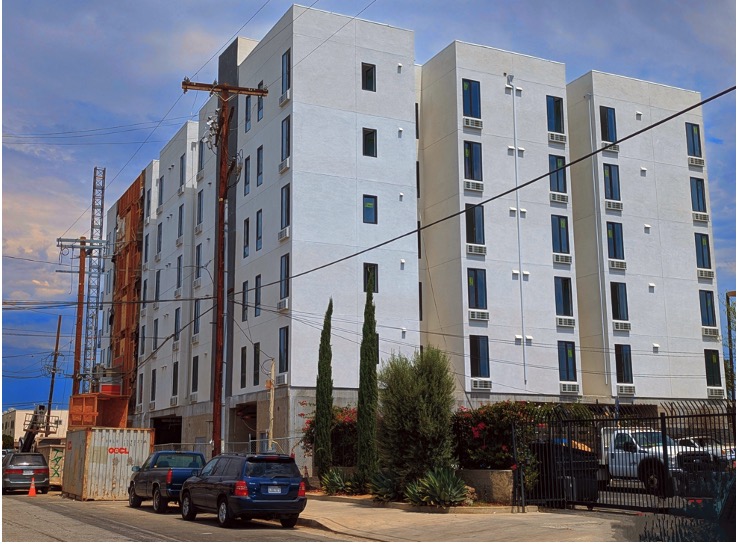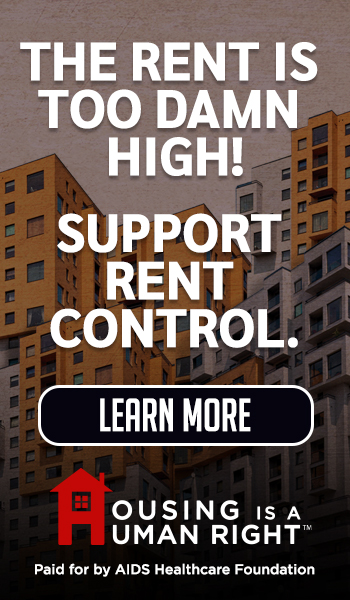Comments
HOUSING - “The immersive ugliness of the built environment in the USA is entropy made visible. It indicates not simple carelessness but a vivid drive toward destruction, decay, and death: the stage-set of a literal “death trip,” of a society determined to commit suicide.” - James Howard Kunstler
Just as you don’t need a forensic psychiatrist to identify pornography, you don’t have to be an art critic to recognize bad design or a dismal scientist to see poor economic policies resulting in massive deficits and higher taxes.
Once celebrated for its architectural diversity, from Spanish Colonial Revival to Googie to modernist masterpieces, Los Angeles is systematically erasing its visual identity in favor of what can only be called architectural brutalism, ballyhooed as postmodern progress. The city's housing crisis has spawned a generation of buildings so aesthetically barren and economically perverse that they threaten to transform entire neighborhoods into modern concrete megaliths of policy failure. At particular risk are our cherished treelined single-family neighborhoods.
Walk through any developing neighborhood in Los Angeles today, and you'll encounter the same depressing sight: rectangular, stucco-clad boxes stacked like shipping containers, or shoeboxes without any of the creativity a six-year-old could bring to the design. Devoid of any architectural character that might distinguish them from a warehouse district or a poorly designed gulag. These "boring boxes," as residents increasingly call them, represent more than just poor design—they altogether abandon human-centered urban planning or an aesthetic that celebrates the human spirit.

The economic drivers behind this aesthetic catastrophe are as predictable as they are destructive. In a city where land costs have reached astronomical heights, construction expenses are twice as high as in Texas. The difference is more expensive labor, longer construction timelines due to a complex permitting process, and much higher municipal development fees, which can be 10 to 40 times greater in California than in Texas. Therefore, developers have reduced architecture to its most primitive form: the rectangle. Every curved wall, every decorative element, every gesture toward beauty is sacrificed on the altar of cost efficiency and maximum square footage extraction.
These structures, often reaching six stories of relentless uniformity, are built with the cheapest materials available—stucco, fiber cement, and low-grade metal panels that begin deteriorating almost immediately under Los Angeles' relentless sun. Within two decades, these buildings will likely resemble the failed housing blocks of East Germany, with sunshine instead of dismal gray, creating instant slums in neighborhoods that once possessed character and charm.
Perhaps nowhere is the absurdity of Los Angeles’s housing policy more evident than in the city's approach to homelessness. Under programs like Proposition HHH, the city has constructed "supportive housing" units at costs exceeding $800,000 each—prices that would buy luxury homes in most American cities. Yet these astronomical expenditures have produced structures so poorly conceived and shoddily built that many sit empty while homeless populations continue to grow.
The hypocritical irony is palpable: in a city where median home prices have forced middle-class families to flee to other states, public officials spend nearly a million dollars per unit to house individuals who, according to independent sources, have retention rates as low as 20-30%. The remainder either reject the housing due to its restrictive conditions or abandon it after stripping saleable fixtures to fund drug purchases.
This isn't compassionate policy; its economic insanity masquerading as social justice. The same $800,000 that builds one supportive housing unit could purchase 80 prefab tiny homes at a cost of about $10,000 in appropriate locations, yet bureaucratic momentum and ideological blindness prevent any reconsideration of this catastrophically expensive approach. If housing is the answer (it isn’t), then would it not be better to house 80 humans instead of one?
In a city built around automobile transportation, Los Angeles has embraced the peculiar notion that eliminating parking requirements will somehow transform car-dependent residents into pedestrians, skateboarders, and cyclists. The result has been predictably disastrous: new apartment buildings with little to no parking dump their residents' vehicles onto surrounding streets, creating a cascade of problems that ripple through established neighborhoods.
Single-family homeowners who followed zoning rules requiring covered parking now compete for street parking with residents of nearby apartment buildings deliberately built without adequate parking. The policy represents a form of class warfare disguised as environmental consciousness; affluent planners impose theoretical ideals on working-class neighborhoods that must live with the impractical consequences.
When you're young, you don’t realize the difficulties that the last half mile or mile can cause for senior citizens forced to use public transportation. For the elderly, the challenges include walking and carrying groceries, navigating stairs, dealing with crumbling sidewalks or sidewalks lifted by tree roots a foot or so above ground level, or walking along a busy boulevard to reach a doctor’s office that’s inconveniently located. Not everyone can afford an Uber or medical transport. Their ability to walk and navigate in extreme weather, something we experience enough of here in Los Angeles, creates an unfair burden on the non-affluent elderly, inflicted by young, bright-eyed planners who have just graduated from college and have been indoctrinated by woke professors to despise cars, fossil fuels, and single-family houses.
The infrastructure strain is immediate and visible: narrow residential streets designed for occasional visitor parking now resemble parking lots, while the constant circulation of drivers searching for spaces increases traffic, noise, and enemy number 1, air pollution. Rather than reducing car dependency, these policies have externalized parking costs onto communities with no voice in the planning process. These urban elite planners never consider where the water to fight fires might come from, or the ageing sewer and water pipes ready to burst. Let alone where the reliable power for their mandated all-electric everything might come from.
Los Angeles housing advocates speak endlessly about "affordability" while presiding over a system that produces the exact opposite. New apartment units, including the cramped "micro-units" celebrated by planners, rent for $2,000 to $2,500 monthly, which would secure spacious homes in most American metropolitan areas. You need to earn over $80,000 a year for these shoebox apartments. They are often smaller than a suburban garage and represent the commodification of human shelter reduced to its most dehumanizing extreme, a virtual prison cell without bars, a small kitchenette, and a slightly nicer commode.
The bitter truth is that Los Angeles has created a housing market so distorted by regulation, taxation, and bureaucratic incompetence that it produces the worst possible outcomes: maximum cost, minimum space, and zero aesthetic consideration. Young professionals are expected to celebrate the privilege of paying luxury prices for spaces that previous generations would have considered unfit for habitation.
Meanwhile, the promised benefits of increased density, reduced traffic, improved public transportation, and vibrant walkable neighborhoods remain a fantasia in the urban planner’s mind as crime causes shopkeepers to give up. Shoplifting and smash-and-grab looters are unaffordable for all businesses, large and small. Even the big box stores are abandoning certain neighborhoods, and supermarkets, the unofficial heart of all neighborhoods, are being pushed out by crime, creating food deserts in their wake and additional economic hardships.
The most damning evidence of Los Angeles' housing failure is demographic: the people voting with their feet. Long-term residents, families, and even immigrants—both documented and undocumented—are abandoning the city in unprecedented numbers. When people who risked everything to reach Los Angeles conclude that the cost of staying exceeds the benefits, the policy failure is absolute. Their tax dollars will also sorely be missed.
This exodus isn't simply about high costs—it's about the complete degradation of urban life that these policies have produced. Who wants to raise children in neighborhoods where six-story apartment blocks cast permanent shadows over single-family homes? Who wants to pay premium prices for housing that looks like it was designed by a committee of bureaucrats from East Germany, aesthetically crippled?
Los Angeles stands at a crossroads between doubling down on failed policies or acknowledging the human cost of its housing ideology. The current trajectory leads inevitably toward a city of expensive slums—a place where astronomical rents purchase substandard housing in neighborhoods stripped of character, charm, and livability.
The solution requires abandoning the theological certainty that currently drives housing policy and embracing pragmatic approaches that acknowledge economic reality, choice, and human dignity. Do $800,000 supportive housing units represent sound public investment? Do parking-free developments truly serve their communities? And does the aesthetic degradation of entire neighborhoods represent acceptable collateral damage in the pursuit of density and lower carbon emissions when the weather has been changing continuously for hundreds of millions of years? Is trashing my gas tankless water heater going to save the planet?
Does any City Planner give a hoot about geology or the recent ice age? FYI, the last ice age ended about 11,500 years ago—a blink of the eye in geological history’s timeline. Shockingly, to most of the climate catastrophists, if they ever found out this fact, Earth is technically still in an ice age. Luckily for us, we are in a warm phase called an interglacial period; colder glacial periods will still occur throughout the broader ice age.
One cannot underestimate the psychological harm caused just by existing in LA. The damage comes from the squalor of encampments lining freeways, sidewalks, and tourist areas. The streets are strewn with needles, human waste on doorsteps and sidewalks, trash piles making the city look like a top-tier garbage dump, graffiti everywhere, and a lack of funds to repair our crumbling roads, water systems, or to replace aging electrical transformers and power lines. Why? Because of housing first. It disrupts the cohesion of neighborhoods and brings in people from different cultures and social strata. And what cannot be said is that these dormitories for those with less often lead to an increase in local crimes. For those forced to live in these conditions, this is not economic justice but cruel, undeserved punishment and a misapplication of community standards and the law.
Until Los Angeles politicians, bureaucrats, and planners take a long, hard look in the mirror, these apparatchiks and their dogmas will continue transforming a city of dreams into a horror show of what happens when ideology overrides common sense. The dull boxes spreading across the landscape aren't just architectural failures; they're a testament to a policy regime that has forgotten cities exist to serve people, uplift humanity, and make commerce and safety possible. The people of Los Angeles deserve better than costly slums wrapped in a facade of black and white (the preferred architectural colors these days), urban blight created and pushed by urban design extremists who have no idea how an ugly, crowded city pits residents against each other, creating unnecessary hardships and making a struggle for space and serenity. We live in a city that resists human flourishing. The urban landscape shouts that if you just look.
(Eliot Cohen has been on the Neighborhood Council, served on the Van Nuys Airport Citizens Advisory Council, is on the Board of Homeowners of Encino, and was the president of HOME for over seven years. Eliot retired after a 35-year career on Wall Street. Eliot is a critic of the stinking thinking of the bureaucrats and politicians that run the County, the State, and the City. Eliot and his wife divide their time between L.A. and Baja Norte, Mexico.)
















